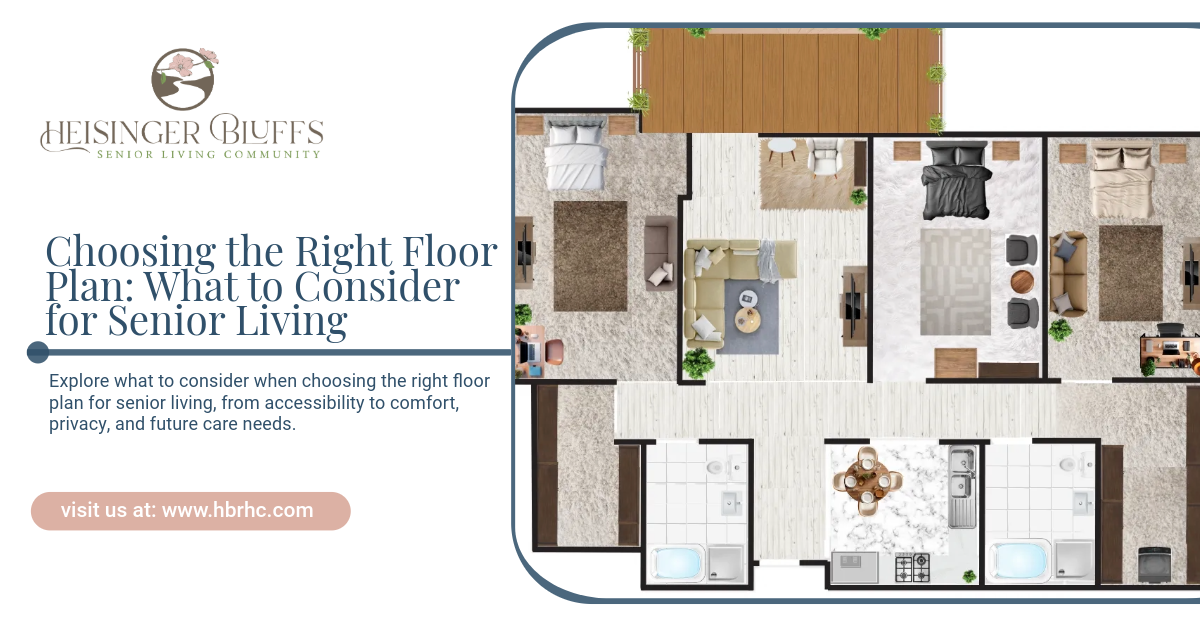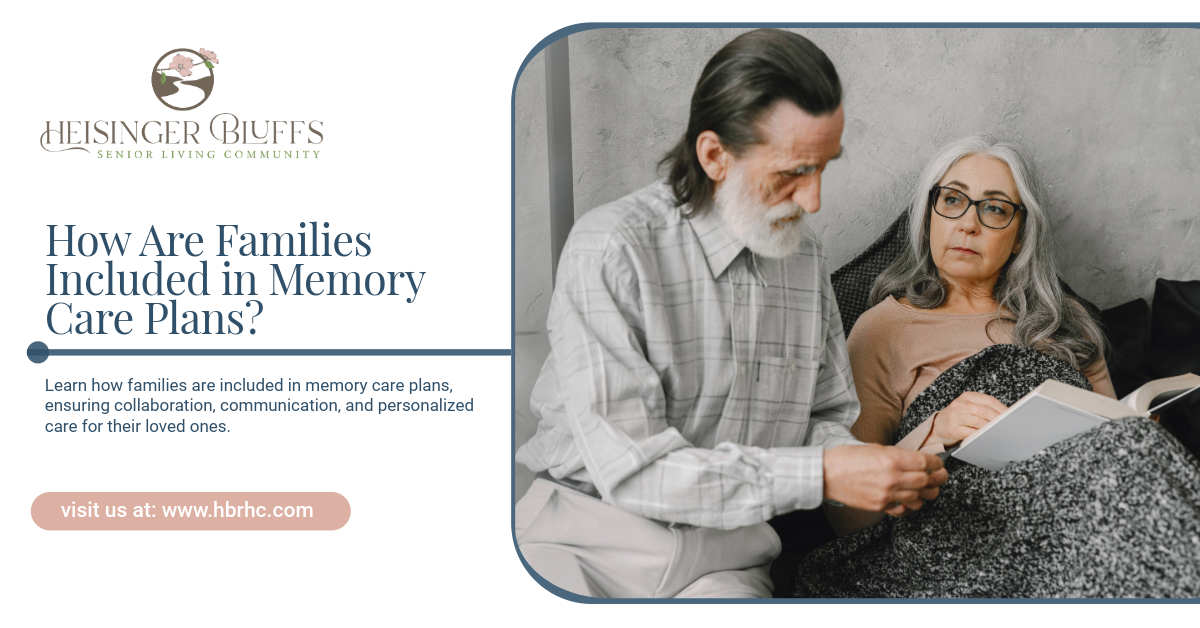Choosing the Right Floor Plan: What to Consider for Senior Living

Selecting the right senior living community is an important decision, but so is choosing the right floor plan within that community. A well-chosen layout can make a significant difference in your comfort, mobility, safety, and enjoyment of everyday life.
Whether you’re planning to move into independent living, assisted living, or any other level of care, this guide will walk you through everything to consider when choosing the ideal floor plan for your lifestyle and future needs.
Why Floor Plans Matter in Senior Living
A senior living community isn’t just a place to reside—it’s your home. The layout of that home plays a key role in:
- Daily comfort
- Ease of movement
- Safety and accessibility
- Privacy and social interaction
- Ability to age in place
Choosing the wrong floor plan could lead to frustration or even physical difficulty, while the right one offers peace of mind and a better quality of life.
Step-by-Step Guide to Choosing the Right Floor Plan
Here are the most important factors to keep in mind when comparing floor plans in a senior living community.
1. Assess Your Current Needs
Begin by making a list of what you need in your daily routine. Consider:
- How much space you use at home now
- What furniture you plan to bring
- Whether you cook frequently or prefer meal services
- How often you host visitors
- If you require assistive devices like walkers or wheelchairs
The goal is to choose a layout that complements your daily lifestyle, not just your theoretical square footage.
2. Plan for Future Needs
While you may be completely independent now, it's wise to plan for future changes. Look for:
- Wide hallways and doorways that accommodate mobility aids
- A step-free entryway and shower
- Easily accessible closets, cabinets, and storage
- Proximity to care facilities within the community
- A layout that allows for home care or medical equipment, if needed
Selecting a floor plan that anticipates possible future health needs helps reduce the likelihood of moving again later on.
3. Evaluate Size vs. Function
Larger doesn’t always mean better. Think critically about how much space you’ll really use. Some questions to ask:
- Will you actually use a second bedroom, or will it become storage?
- Is an open-concept living and kitchen area more practical for entertaining or moving around easily?
- Are you downsizing from a larger home and struggling to let go of excess items?
Choosing a floor plan should be about efficiency and comfort, not excess.
4. Consider Layout and Flow
Pay attention to how the space is arranged. A smart floor plan will:
- Have clear separation between public (living room, kitchen) and private (bedroom, bathroom) spaces
- Offer an easy path from one room to another, especially from bedroom to bathroom
- Limit the number of sharp corners or awkward turns that can make moving difficult
- Provide natural light and windows in key areas
The more intuitive the layout, the easier and safer it is to navigate daily.
5. Think About Storage Space
Seniors often downsize, but many still need ample storage for essentials, memorabilia, seasonal items, or hobbies. Check:
- Closet space in the bedroom
- Cabinets in the kitchen and bathroom
- Entryway storage for shoes, coats, or walkers
- Storage options for linens, laundry, and cleaning supplies
A well-designed floor plan won’t leave you constantly wondering where to put your things.
6. Kitchen Considerations
Even in independent or assisted living where meals are provided, many seniors still want a functional kitchen. Consider:
- Whether you’ll cook occasionally or just need a microwave and fridge
- If appliances are modern, easy to reach, and user-friendly
- The height of counters and cabinets
- Safety features like induction cooktops or easy-to-use knobs
For avid home cooks, a full-size kitchen might be non-negotiable. For others, a kitchenette may be more than enough.
7. Bathroom Design Is Critical
Bathrooms are one of the most important rooms when it comes to safety and accessibility. Look for:
- Walk-in showers with grab bars
- Non-slip flooring
- Easy-to-reach sinks and storage
- Space for assistive devices or a shower chair
- Good lighting
A well-designed bathroom should reduce fall risk while remaining private and comfortable.
8. Bedroom Comfort and Functionality
Your bedroom should feel like a personal retreat. Make sure it offers:
- Enough room to move around the bed with ease
- Good natural light
- Proximity to the bathroom
- Room for nightstands, dressers, and any personal items
- Privacy from common areas or guest spaces
If you enjoy reading, relaxing, or watching TV in bed, ensure the layout supports these habits.
9. Consider Guest Needs
Do you plan to have visitors often? A second bedroom or den could be helpful for:
- Overnight guests
- Grandchildren visiting
- Hosting hobbies or game nights
- Setting up a computer, crafting, or reading room
However, if you rarely entertain or travel to see family, you may prefer a one-bedroom floor plan and enjoy the cost savings.
10. Look at Natural Light and Views
Having windows in key areas such as the living room, bedroom, or kitchen can make your space feel larger, more vibrant, and more inviting. Ask yourself:
- Will I enjoy the sunrise or sunset from my unit?
- Is there a view of nature or the community gardens?
- Are windows easy to open and close?
Sunlight and scenic views have been shown to boost mood and overall well-being, especially for seniors.
11. Accessibility and Mobility
Even if you don’t currently use a mobility aid, that could change in the future. Look for:
- Wide doors and clear floor space
- Minimal thresholds or steps between rooms
- Accessible switches, outlets, and thermostats
- Lever-style door handles and faucets
A good floor plan will allow you to age in place gracefully and safely.
12. Location Within the Community
Don’t forget to consider the location of the unit itself within the building or campus. Ask:
- Is it near the dining room, wellness center, or social areas?
- Does it require using stairs or long hallways frequently?
- How far is it from parking or the elevator?
- Is it on a quieter floor or area of the building?
The placement of your home within the broader community impacts your day-to-day life just as much as the layout inside.
Questions to Ask When Touring Senior Living Floor Plans
When you’re reviewing different options, bring these questions to ask:
- Can I walk from the bedroom to the bathroom easily in the dark?
- Is there room for my furniture, or will I need to downsize more?
- Will the layout work if my mobility changes?
- Is there enough storage for clothes, cleaning items, and personal mementos?
- Do I feel comfortable and “at home” here?
If the answer is yes to most of these questions, it may be the right floor plan for you.
Making It Feel Like Home
Once you’ve selected your ideal layout, it’s time to personalize your space. Consider:
- Bringing meaningful art, photos, and keepsakes
- Choosing comfortable furniture that suits the room’s dimensions
- Adding lighting, rugs, or curtains to make the space feel warm
- Incorporating plants or small indoor gardens
- Designing a cozy reading nook or hobby station
Even in a new environment, these touches can help make your space feel like yours.
Final Thoughts
Choosing the right floor plan for senior living is about balancing your current lifestyle, future needs, and personal preferences. It’s not just about square footage—it’s about safety, functionality, and comfort.
When you take the time to evaluate your options, ask the right questions, and envision how you’ll use the space, you can find a layout that supports your independence and enhances your quality of life.
Heisinger Bluffs, a senior living community in Jefferson City, offers a variety of thoughtfully designed floor plans for both independent and assisted living. Whether you're looking for a cozy one-bedroom apartment or a more spacious two-bedroom suite, there's a layout that fits your needs and lifestyle, with the added benefit of riverfront views, beautiful amenities, and compassionate support. Contact us today!
Frequently Asked Questions
How do I choose between a one-bedroom and two-bedroom unit?
Consider your lifestyle, guest habits, and how much space you actually use. If you host often or want a dedicated hobby space, a two-bedroom might be right. If not, a one-bedroom may offer all the space you need at a lower cost.
What safety features should I look for in a floor plan?
Look for grab bars, step-free showers, wide doorways, non-slip flooring, emergency call systems, and good lighting. These features support mobility and reduce the risk of falls.
Can I customize or decorate my apartment in senior living?
Yes! Most communities encourage residents to personalize their apartments with furniture, décor, artwork, and meaningful items that make it feel like home.
Sources:
- https://www.hopkinsmedicine.org/health/caregiving/assistive-equipment-for-the-home
- https://pmc.ncbi.nlm.nih.gov/articles/PMC3134333/











